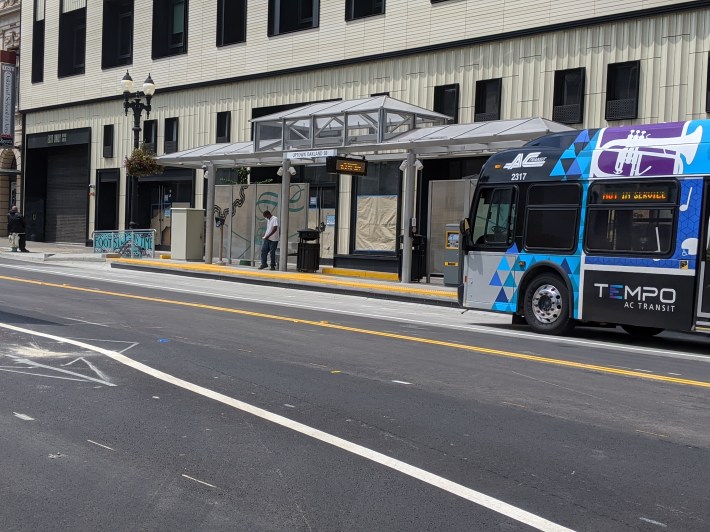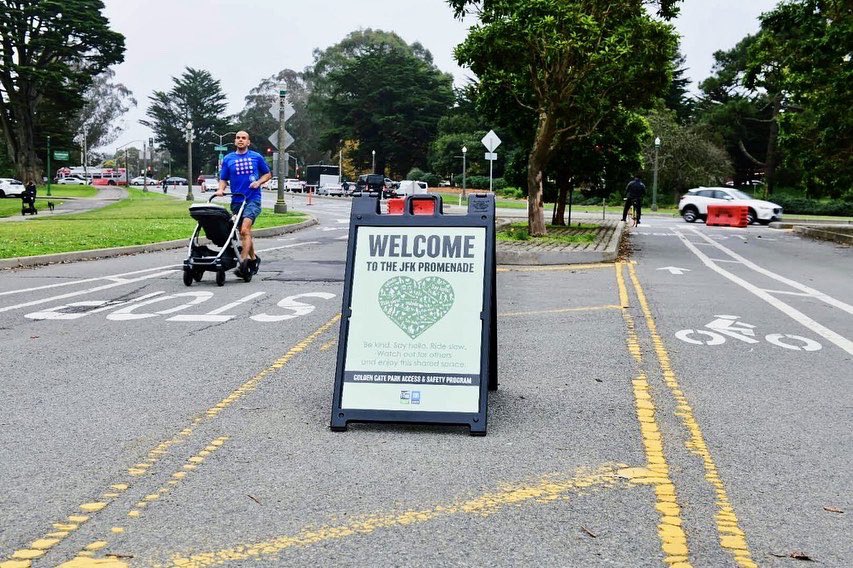Here are a few Streetsblog news nuggets to start your weekend.
The City of San Francisco going all-in on car-free J.F.K.
For some time now the powerful de Young trust, via its paid lobbyists, has been trying to quash the dream of a car-free J.F.K drive in Golden Gate Park. The city has waffled on this topic, but it seems things are again moving in the right direction.
From an SFMTA release:
Starting January 5, 2022 you’ll find new signage all along the promenade route reminding users to be kind, share the space, move slowly, and say hello to each other. Through over 50 outreach events held by the Golden Gate Park Access & Safety Program team throughout the fall and over 10,000 survey responses we received, San Franciscans have overwhelmingly said they appreciate the space for walking and rolling along JFK Drive—but also want to see more guidance on how to use the space. In response, the SF Recreation & Park Department and SFMTA co-designed this courtesy campaign to encourage park users to put safety and kindness first when navigating the promenade.
The San Francisco Chronicle editorial board is now also strongly on the record for the promenade. From "JFK Drive is for people, not car commuters. Let’s keep it that way in 2022 and beyond":
Before the pandemic, JFK was one of the most dangerous and deadliest streets in San Francisco. There were 91 crashes on it from 2014 through its 2020 closure. That’s mostly because 75% of people traveling on JFK had no intention of visiting the park; they were simply using it as a cut-through. This would be a policy failure for any city; for a supposedly transit-first city like San Francisco, however, it was an inexcusable display of incompetence.
And:
To ensure JFK remains a safe and enjoyable space, worthy of one of the most stunning urban parks in the world, it should remain closed to cars in 2022 and beyond.
It must sting the de Young trust a bit to know the newspaper that originally built their wealth is now officially in their face. Of course, the de Young no doubt will never stop gaslighting--pretending this is an equity issue or that there isn't a giant underground parking garage available for people who arrive by car. That's why the hard-working advocates at Walk S.F. are continuing their postcard campaign to protect car-free JFK.
Sign up to volunteer here.
California High-Speed Rail project gets more good news from the feds

Streetsblog readers may recall that for years HSR opponents, including rail-catastrophizer-in-chief Ralph Vartabedian of the L.A. Times, predicted that the state would miss construction deadlines and be on the hook for $2.5 billion in federal matching funds connected to the Obama-era American Recovery and Reinvestment Act. Well, this week the authority has officially met its grant requirements.
From a California HSR-release:
The Federal Railroad Administration (FRA) has notified the California High-Speed Rail Authority (Authority) that it has fully met its state funding match requirements for federal dollars one year ahead of schedule. Today’s action completes a major requirement of the American Recovery and Reinvestment Act funding grant.
“The federal government’s investment in this transformative project has been matched, dollar for dollar, a year ahead of schedule,” said Authority Chief Financial Officer Brian Annis. “With a strong, engaged federal partner, we’re able to continue moving forward in delivering electrified high-speed rail for the people of California.”
The Authority expended the $2.5 billion in federal ARRA funding by the September 2017 statutory deadline. The funding advanced the 119-mile backbone of the state’s high-speed rail system in the Central Valley, a historically disadvantaged part of the state notorious for poor air quality. The FRA required the Authority to match the expenditure of federal funds with state funds for qualified expenses by December 2022.
This is big news. And it's good news. Waiting to read your succinct coverage, LA Times. Chirp, chirp, chirp.
Oakland launches ‘Universal Basic Mobility’ pilot

One of the founding principles of this blog is that mobility is a basic human right. That's why Streetsblog argues that building cities where residents must buy and maintain an expensive car to get around is inherently inequitable. And everybody should be able to move about regardless of their economic status. It seems the City of Oakland agrees, with its 'Universal Basic Mobility' plan.
From an OakDOT release:
As part of its innovative Universal Basic Mobility pilot, the City of Oakland Department of Transportation (OakDOT) announced today that it has successfully distributed 500 prepaid debit cards to East Oakland residents and employees. These cards are restricted to use purchasing trips or passes on public transit, bikeshare, and shared e-scooters. Program participants began with $150 available on their cards. After recipients complete a survey in January, the second and final disbursement of $150 will be loaded to their cards. The goal of the Universal Basic Mobility pilot is to increase walking, biking, public transit, and shared mobility trips in East Oakland while reducing drive-alone private vehicle trips.
"The Universal Basic Mobility Pilot leverages the tremendous investment in the East Bay's first bus rapid transit (BRT) line by making rides on public transit, bikeshare, and e-scooters available at no cost to participants,” added OakDOT Director Ryan Russo. “Eliminating financial obstacles to mobility is critical to supporting the needs of East Oaklanders who most struggle with the twin costs of housing and transportation."
For more information, click HERE.





